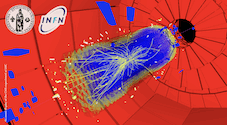Speaker
Mr
Henry Brown
(University of Liverpool)
Description
LHCb is a dedicated experiment to study new physics in the decays of beauty and charm hadrons at the Large Hadron Collider (LHC) at CERN. The beauty and charm hadrons are identified through their flight distance in the Vertex Locator (VELO), and hence the detector is critical for both the trigger and offline physics analyses. The VELO is the highest resolution vertex detector at the LHC.
The VELO is the silicon detector surrounding the LHCb interaction point, and is located only 7 mm from the LHC beam during normal operation. The VELO is moved into position for each fill of the LHC, once stable beams are obtained. The detector is centred around the LHC beam during the insertion by the online reconstruction of the primary vertex position. The detector operates in an extreme and highly non-uniform radiation environment. The effects of surface and bulk radiation damage have already been measured.
Radiation damage is studied in the VELO through the measurement of IV curves, noise versus voltage, and charge collection efficiency versus voltage. IV curves are taken weekly on the detector at the operating temperature (-10C), and warm IV curves are taken at up to +25C during the shutdown - this has allowed the separation of bulk and surface effects. The detector was annealed over the 2010-2011 shutdown and the effect of this is also seen and compared with the prediction. noise versus voltage scans are also taken monthly. In addition an automatic procedure has been defined which scans patterns of one in every four detectors in voltage, while maintaining the other detectors at operating voltage. This allows charge collection efficiency to be studied using the detectors at nominal voltage for tracking. This procedure has allowed the radiation damage as a function of radius to be studied.
The VELO consists of two retractable detector halves with 21 silicon micro-strip tracking modules each. A module is composed of two n+-on-n 300 micron thick half disc sensors with R-measuring and Phi-measuring micro-strip geometry, mounted on a carbon fibre support paddle. The minimum pitch is approximately 40 µm. The detector is also equipped with one n-on-p module. The detectors are operated in vacuum and a bi-phase C02 cooling system used. The detectors are readout with an analogue front-end chip and the signals processed by a set of algorithms in FPGA processing boards. The performance of the algorithms is tuned for each individual strip using a bit-perfect emulation of the FPGA code run in the full software framework of the experiment.
The VELO has been successfully operated for the first LHC physics run. Operational results show a signal to noise ratio of around 20:1 and a cluster finding efficiency relative to the design of 99.5 %. The small pitch and analogue readout, result in a best single hit precision of 4 µm having been achieved at the optimal track angle.
Summary
Submitted by the project leader, the speaker will be identified once the talk is accepted.
Author
Mr
Henry Brown
(University of Liverpool)

